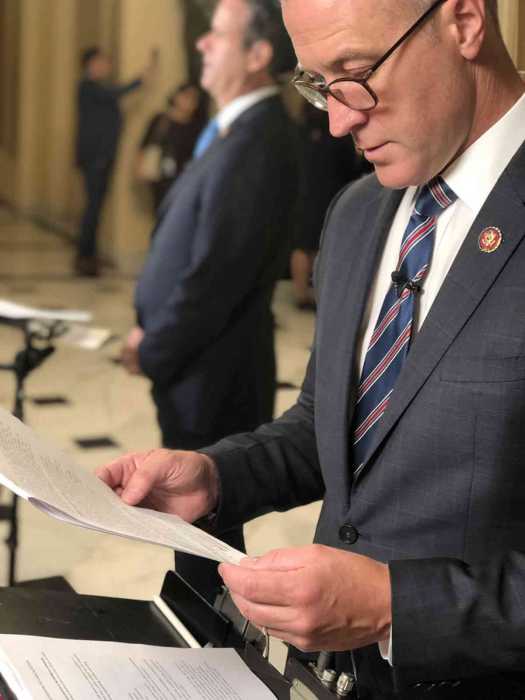US military branches are either withholding details about how many service members have been discharged as part of the April 12 ban on transgender troops or denying any discharges have taken place, based on interviews with spokespersons representing each of them. And there are signs of serious dysfunction in the way the policy has been carried out, including apparent misrepresentation of it by the Pentagon itself.
Representatives from multiple military branches told Gay City News that the discharge of transgender service members is not tracked at all, reflecting a level of disorganization reminiscent of the Trump administration’s family separation policy in which government officials failed to reunite families after ripping them apart at the border.
A spokesperson for the Department of Defense initially told Gay City News that the military would provide the number of service members discharged as part of the policy. But when the branches were contacted individually, the Air Force, Army, Navy, and Marines offered a variety of responses, with two essentially dead-ending the discussion by making clear they would not be providing transparency in the way they are carrying out the ban first announced by President Donald Trump in a July 2017 tweet. After a protracted legal battle that is not definitively concluded, the new policy was finally implemented this year.
Trump, who has stacked the federal courts with far-right justices at every turn, appeared to land a victory in the ongoing fight on June 14 when the Ninth Circuit Court of Appeals said a lower court ruling against Trump’s ban did not take into consideration the difference between the ban proposed by former Defense Secretary Jim Mattis and the original ban announced by Trump in 2017.
The military has insisted that the new policy does not constitute a blanket ban on transgender service members because certain service members are exempt from the policy — a key piece of the administration’s effort to uphold the ban in court. That narrative has widely been rejected because transgender troops with a diagnosis of gender dysphoria would be presumptively disqualified for service unless they were already serving and willing and able to serve in their biological gender at birth. No matter how the policy is spun by the military — and a Pentagon spokesperson repeatedly insisted that trans folks, under certain circumstances, could serve in their true gender identity — transgender folks are effectively banned from the military.
Inquiries sent to the military specifically asked how many people have been discharged as part of “the policy,” but multiple branches of the military did not answer that question, instead turning to their narrative that the military does not ban people on the basis of gender identity alone.
A spokesperson for the Army initially said, “DOD policy prohibits involuntary separation solely on the basis of gender identity.” But when pressed again to answer how many people have been discharged as part of the policy, a spokesperson claimed, “There have been no discharges.”
Navy spokesperson Samuel R. Boyle said the Navy “does not track those numbers because of privacy concerns,” while Air Force spokesperson Nicholas J. Mercurio said, “The Air Force does not refer members for separation proceedings based solely on their identity as transgender and as such does not track transgender identity among discharged members.”
A spokesperson for the Marines said, “Zero Marines have been separated under the Department of Defense policy on military service by transgender persons and persons with gender dysphoria.”
The Marines echoed the same message as other branches, saying they do not “separate transgender service members solely because they are transgender.” However, their spokesperson elaborated more than any of the other branches.
“If someone received a diagnosis of gender dysphoria on or after April 12, 2019, and gender transition is medically necessary, they may be separated,” Major Craig Thomas of the Marine Corps said. “Depending on any conditions adversely affecting performance, they could be directed to the DoD/ Veteran Affairs Integrated Disability Evaluation System or they could be separated for a condition not a disability.”
The Coast Guard acknowledged requests for comment and spent days saying they were gathering information regarding discharges, but did not provide a formal response by press time.
The claim by the Marines and the Army that there have been no discharges is difficult to square with assertions by the Air Force and the Navy that no tally is being made, suggesting either a lack of candor or glaring inconsistencies in the way the policy is being enforced. And it difficult to reconcile these responses with assertions by President Donald Trump that banning transgender troops was an economic decision for a military that enjoys a whopping $686 billion budget. If the president’s claim were true, the Pentagon would presumably be keen to track the progress in ridding the military of these expensive transgender troops.
In defending the new policy in an interview earlier this month with Piers Morgan of “Good Morning Britain,” Trump made numerous false statements. The president said trans troops “take massive amounts of drugs” and he incorrectly stated that people are not allowed to take any drugs while serving in the military.
“We’d actually have to break rules and regulations in order to have that,” he asserted when discussing trans service members taking medications. “It is what it is… The operation is $200,000, $250,000, the recovery period is long, and they have to take large amounts of drugs after that… You can’t do that.”
Department of Defense spokesperson Jessica Maxwell told Gay City News on June 6 that individuals who were diagnosed with gender dysphoria prior to April 12 are “generally exempt” from the new policy and that those people “may serve in their preferred gender and will continue to receive all medically necessary treatment.”
When Maxwell was asked about language in the new policy that states that “unless exempt,” current serving personnel with a gender dysphoria diagnosis must serve in their “biological sex,” she responded, “The word ‘exempt’ is key here. So if someone already had a care plan in place, such as the need for hormones, that person would be exempt from the new/ 2018 policy.” That distinction has never before been made clear or explained by the Pentagon, and is difficult to square with another point she made next.
Maxwell continued, “Service members diagnosed with gender dysphoria who are not exempt from the new policy may consult with a military medical provider and receive mental health counseling. If gender transition treatment is required, the service member will be evaluated for potential discharge, but all medically necessary care will be provided in the meantime.”
Multiple transgender service members sounded off on the military ban in written statements to Gay City News this month. Navy veteran Camden Ador of Queens said Trump’s claims are “unfounded and based in bigotry, as many of us have come to realize,” while Brooklyn-born retired Navy Commander Shawn Skelly, another trans veteran, said Trump is directly targeting the trans community and that the military ban is just one of many ways he is carrying out his transphobia.
The president has handed healthcare providers the right to discriminate against trans patients, is trying to allow shelters to ban trans people, and rescinded Obama-era rules protecting transgender students to use bathrooms consistent with their gender identity.
“It’s the most prominent part of a broader administration campaign to drive transgender people out of the mainstream of American society through the deliberate removal of legal recognition and protections of every sort,” Skelly said.




































